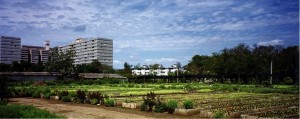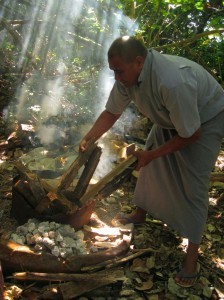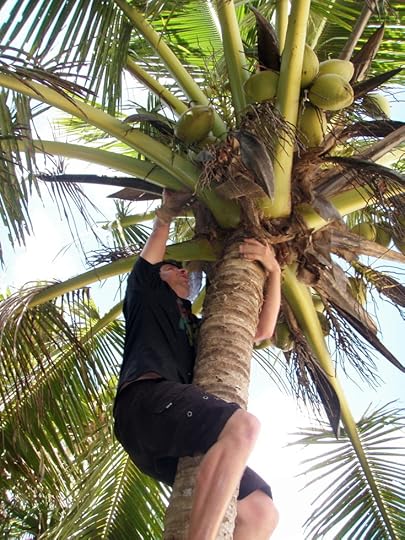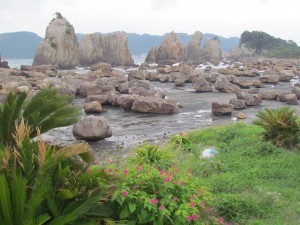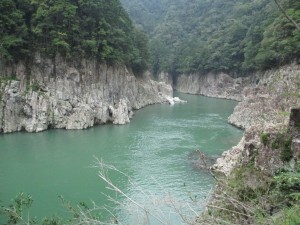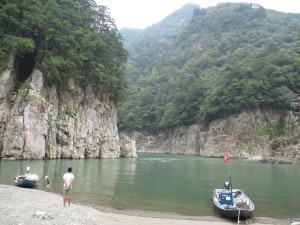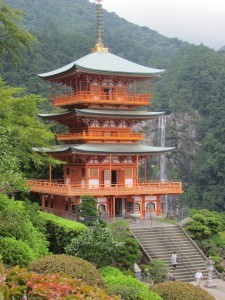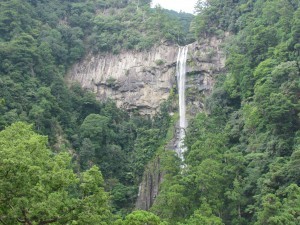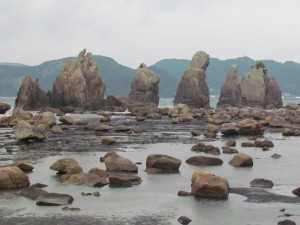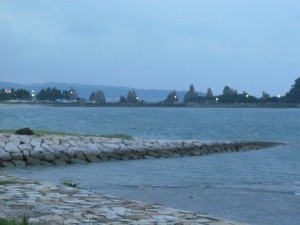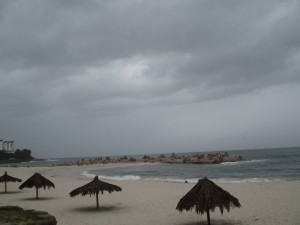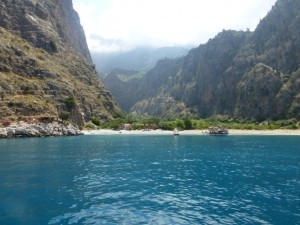Lisa Niver's Blog: We Said Go Travel, page 466
September 30, 2013
Kenya: My Beautiful African Home
 “Ladies and gents, we are about to start our decent!” shouted the pilot as he turned in his squeaky seat just in front of me. Yes, there were no doors separating the pilot’s cabin from the main cabin of the tiny Blue Sky Airline’s operated Cessna Caravan 208B. Nor were there seatbelts, luggage storage or uniformed, smiling flight crew. The two hour bumpy flight across the Masai Mara savannah was about to be over. These were the words I dreaded every summer when I was a kid. I could never understand how my brother could sleep so blissfully throughout these flights. Nor could I understand how dad would be calmly getting his camera ready whilst mom would be gazing out through the window, trying to spot our home for the next few months. I was the only one who was nervously clinging to the sides of the worn leather seat.
“Ladies and gents, we are about to start our decent!” shouted the pilot as he turned in his squeaky seat just in front of me. Yes, there were no doors separating the pilot’s cabin from the main cabin of the tiny Blue Sky Airline’s operated Cessna Caravan 208B. Nor were there seatbelts, luggage storage or uniformed, smiling flight crew. The two hour bumpy flight across the Masai Mara savannah was about to be over. These were the words I dreaded every summer when I was a kid. I could never understand how my brother could sleep so blissfully throughout these flights. Nor could I understand how dad would be calmly getting his camera ready whilst mom would be gazing out through the window, trying to spot our home for the next few months. I was the only one who was nervously clinging to the sides of the worn leather seat.
Then there was always the inevitable sharp turn and all I was able to see through a scratched window was a rusty blue metal propeller, which reminded me of a horror film, and the dark orange cracked ground dotted with tiny black spots, which were the herds of animals. The first year we landed in amongst a herd of zebras. The second year it was warthogs. Wondering what it would be this year used to take my mind off the landing for a few minutes and from the sickening scenario of the plane crashing.
Once the thick cloud of dust, raised by the animals trying to escape the landing strip, settled down, we saw the familiar faces of the Maasai people. Their skinny tall bodies were wrapped in dark red and purple checked sheets. The Maasai always had extensive weaves of beaded jewelry as well as piercing all over their bodies. “Jambo! We’ve missed you”. Suddenly all the fear and tiredness was forgotten and the warm sense of belonging filled my heart. I knew the best days of the year were ahead.
Waking up at 5am everyday was a challenge, but watching the bright yellow sun slowly rising in the dark orange sky uncovering the weirdly shaped acacia trees in the horizon was worth it. After a hearty breakfast with the wild monkeys, the freezing water barrel bath was waiting. The only motivation was that once we were done, we would be hopping in a khaki coloured jeep, made to blend in with the wilderness, and spend the day animal spotting. One day it was baby lions playing around with each other, their mouths red covered in blood after a hunt; another day it was a big mama elephant chasing our jeep across the savannah for getting too close to her baby or lazy hippos slowly crossing the Mara River at feeding time.
The hours spent in that jeep hidden behind brown dried out bushes waiting for nature to come alive were filled with the thrill of the unknown and the appreciation of these once in a lifetime moments.
It was during the summers when the TV was replaced with novels about Africa; the Internet with human interaction and parties with bonfires nights listening to the local legends. African nights were highlighted by dark blue skies with millions of bright white stars which drew the perfect signs of the zodiac. You could also spot the wildebeest silhouetted against the stunning night sky, appearing to be completely captivated by the stars. I have never seen such beautiful skies anywhere else in the world.
The writer Pico Iyer said “…home has really less to do with a piece of soil than, you could say, with a piece of soul.” And I completely agree. Kenya will always be home for me. The wild animals and the Maasai people became family and the wonderful savannah under starry skies became home. It’s a place where I have learnt to explore, respect and appreciate nature and take responsibility for preserving it. The summers there were not only sacred because of all the beauty that filled my heart but they also taught me more than any formal education I have ever had and I will always be grateful that I got to experience this beauty before it got destroyed bit by bit by mass tourism.
About the Author: Milda is a Travel Community Manager @ AsiaRooms.com. Born in Lithuania, studied in the UK, traveled around Asia and taught in Africa. Now residing in Singapore, she is wandering around Asia blogging about her travels. Her free time is dedicated to yoga (anytime and anywhere) and capturing her best moments in photos and films!
The post Kenya: My Beautiful African Home appeared first on We Said Go Travel.
Urban Agriculture in Cuba
When you think of Cuba, some of the first things to come to mind are likely to be cigars, rum cocktails and its colourful revolutionary history. You may be surprised to learn, however, that Cuba is a world leader in the field of urban agriculture, with more than half of its produce now grown in a city environment. Cuba’s capital, Havana, has developed a model of inner-city food production that is currently emulated in many other cities, including Detroit and Istanbul.
The origins of the practice
During the era of the Soviet Bloc, Cuba’s food was largely imported from overseas, along with agricultural supplies and raw materials. In 1989, when the Soviet Union collapsed, Cuba experienced the sudden onset of food shortages and responded in an innovative and proactive way. With a US embargo in place, fuel had been in short supply, making transport of crops from rural areas difficult to maintain and it quickly became obvious that local solutions would be vital, so residents began planting food crops in any available space. In cities, such as Havana, this included back yards, porches and derelict spaces in their neighbourhoods.
Development
The Ministry of Agriculture soon recognised the value of this endeavour and began to support the citizens, in conjunction with government officials in Havana, by clarifying legal issues over land use and providing growing space, free of charge, to anybody who wanted it. With the introduction of organic cultivation methods, developed by government horticulturalists, as well as simple irrigation equipment, the production of food in urban spaces grew and the practice continues to increase, providing ample food for Cuba’s population and ensuring the Cuban cuisine is not just tasty but healthy as well.
Agriculture tourism
In addition to being interesting as a socio-economic phenomenon, Havana’s agricultural developments are a draw for tourists who want to experience this unusual way of life and to sample the fresh food which is produced this way. Not only can tourists visit these organic smallholdings, but they can also volunteer on them in much the same way as volunteers get involved in the Israeli kibbutz system. Whilst staying on the farms, travellers enjoy the simplicity of a lifestyle that is rarely seen in more industrialised nations, including the UK, as well as witnessing an extraordinary success story first hand. One of the great advantages of holidaying in one of Havana’s urban farms is that you are able to enjoy the great outdoor experience of a country holiday, whilst being close enough to all of the city’s tourist attractions to pay them a visit.
As Cuba is a popular holiday destination, it is very easy to book flights from the UK. For added convenience, Heathrow provides long-stay parking facilities in conjunction with an overnight stay at their hotel, allowing you to be well rested before the fairly long flight. After all, if you’re going to be volunteering, you’ll need to save your energy for digging.
About the Author: Ruth Kennedy is passionate about travel, politics and writing. She mostly writes about travel and current affairs, in between trips abroad whenever possible. She writes from her home in the UK, which she shares with her dog Billy.
The post Urban Agriculture in Cuba appeared first on We Said Go Travel.
September 29, 2013
Survivor, Sri Lanka
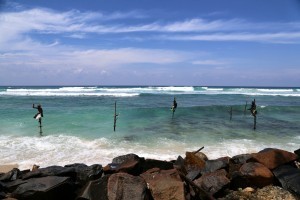 Survivor, Sri Lanka By Paul A. Freitas
Survivor, Sri Lanka By Paul A. Freitas
Have you ever wanted to go somewhere that you have never been but have no idea which destination to choose? You just point to a place on the map and go right? This is exactly how I ended up white knuckling the rear door handle of a car in downtown Colombo, Sri Lanka. From the moment I crossed the threshold at Bandaranaike International Airport into the oppressively heavy air of Sri Lanka, the world blurred and moved in fast forward. I was led to the taxi that would take me to my first stop of the trip and we were under way. Three minutes into the ride, I was thankful for a driver that knew what he was doing. I could instantly see opportunities for death around every turn were the streets filled with tourists. Instead, they were filled with tuk-tuks. These are three wheeled motorcycle cars that are more affordable than your everyday sedan yet much less stylish. Colombo is also where I learned that a 125cc motorcycle doubled as a vehicle for a family of four with an age range from three to seven years old. Oddly enough, only the adults seemed to wear helmets.
About a 55 minute drive from the airport, and I reached the hotel, though I planned for a five minute drive thanks to the person on the phone. Due to the miscalculation, five minutes of overly hot water and a towel that would not get me dry no matter how hard I tried and was on the road again. My destination was Yala National Park on the eastern side of the Sri Lanka. As I settled in for the seven hour drive, I felt adrenaline slow, adjusting to the speed of things happening around me. Thanks to my driver giving me the grand coastal tour however, seven hours was another major miscalculation.
Our first stop was at the sea turtle hospital in Galle. Sri Lanka is home to five of the seven recognized species of sea turtles. The shelter finds the eggs, hatches them in a safe location, and returns the babies to the ocean to avoid people poaching the eggs. There were also several injured turtles that had been saved from nets and boat accidents in the tanks.
From here, it was on to our next stop just south of Galle where I got to photograph the Sri Lankan stilt fishermen (see image below). These fishermen wake up every day and swim out to their stilts (sticks entrenched into the sea floor) where they sit and fish for coral fish. The cousin of the men said that these stilts were handed down from father to son for generations. While the fish do not fetch an incredible amount of money at market, they are food enough to feed the family. I finished photographing and was back in the taxi for the duration of the trip to Yala.
Upon arriving in Yala, I met with my camping host and tour guide. Though I was late by three hours, they decided there was still enough light for an evening animal safari. It was on this safari that I viewed my first ever wild “big cat”, the leopard. Yala National Park is home to one of the largest populations of leopards in the world. While this statement makes it sound like leopards are in great abundance, the truth of the matter is that Yala has approximately 35 leopards, truly sad for being one of the largest leopard populations in existence. The next few days of my trip were spent roaming through Yala National Park to see and photograph many of the various types of flora and fauna.
As my time drew to an end, I was able to visit Udawalawe National Park. Udawalawe has a reputation for its vast numbers of Sri Lankan Asian elephants (200+). I was also fortunate enough to visit the Elephant Transit Home Orphanage. The orphanage is home to juvenile abandoned elephants that are found and reported from all corners of the island. The elephants are raised and encouraged to refine their natural instincts until they are old enough to be released back into the park. Upon release, they are collared with giant radio transmitters to ensure that they are adapting to their new life in the wild.
While I was sad to depart from my new friends and Sri Lanka, visiting truly made me appreciate the things that I have. Sri Lanka is seemingly a poor country. Though its citizens make do, I could see that it was a very hard way of life. All of the people welcomed me with open arms and lots of food! From not knowing where to go, to not wanting to leave, Sri Lanka definitely ranks within my top 10 list of amazing destinations.
About the Author: Paul Freitas is from Salem, Oregon in the United States but has been working as a contractor in Afghanistan for the last 4.5 years. He is currently attending classes for travel photography at MatadorU and is also working towards a degree. He can be reached on Facebook at or on Twitter.
The post Survivor, Sri Lanka appeared first on We Said Go Travel.
12 Must-Experience Tonga Moments, Part 2
Smiles are the currency of Tonga.
The man with the battered boom box wore one as he swayed to a steel drum beat. Grinning at nothing in particular, one hand held the portable machine while the other slapped out a rhythm on his thigh.
“Hey prince, hey princess,” he called out to us, “welcome to paradise!”
The shop keeper across the street thought he was crazy. While my boyfriend and I payed for dusty supplies – bottled water and batteries from China – she smirked bemusedly. “Every day the same…”
Still grooving, he shouted again as we stepped back into the harsh sun. “We got the beach, we got the sea, we got everything we need. This is the real paradise.”
Though Tonga has a high unemployment rate, basic necessities are limited, and the country doesn’t even appear on most world maps, sour faces are a rarity. Once called ‘The Friendly Isles’, this is the only South Pacific country to escape colonization. So while it seems under-developed on the surface, Tonga is rich in less tangible qualities: history, environment, morale.
To capture the wealth of this remote country, here are six more moments you must experience in Tonga:
7. Eat an umu. Prepared across the South Pacific, from New Zealand to Hawaii, this Polynesian meal is cooked in the ground. Basic ingredients – fish, chicken or pork, the starchy taro root, sweet potatoes – are laid over taro leaves (or foil, in the modern version). Next, the raw mixture is drenched with coconut milk. The package of food is then placed in a pit with hot coals and covered up for an hour or two. Most Tongans prepare an umu on Sundays, so it can slowly roast while they attend church. Ask your hostel or guesthouse if they can show you how this traditional meal is created.
8. Try ota ika.
Trevally and the sword-nosed Marlin are prize fish caught off Tonga’s shores. While anglers come for the chance to reel in one of these giants, the daily fish markets showcase a plethora of smaller ocean creatures. A national dish, called ota ika – literally, “raw fish” – features diced fresh seafood, mixed with finely-chopped tomato, onion, coconut and lime juice.
9. Ponder the Trilithon.
Little is known about the ancient stone Trithalon that towers vigilantly from a lonely square of grass on Tongatapu’s northern coast. Though the Stonehenge-like structure has been dated to the 13th century, the facts of its existence are few and hypothetical. Common myth holds that the three stones are too large for human movement and can only have been placed by the Polynesian demigod, Maui.
10. C ut down a coconut.
The local boys make it look easy, shimmying up a narrow palm tree as if they were climbing stairs. While the ascent requires a bit of upper-arm strength and dexterity, it’s a worthy effort for the fruit clustered at the top. The smaller, green coconuts are young and better for milk; older, tougher nuts provide the best flesh. To open, find something sharp, like a rock or strong stick, and poke through one of the nut’s three natural ‘eyes’. In this conservative country, it’s one of the few things you’re allowed to drink in excess.
11. Take the ferry.
Don’t Google it first: news of the 2009 disaster, when the MV Princess Ashika sank and 74 persons were lost at sea, will worry even the bravest travelers. But sailing conditions have improved with foreign investment, and the ferry remains the most authentic way to move between islands. An airplane might be faster – the boat ride between Tonga’tapu and its outer chains can take anywhere from three days to a week – but it doesn’t involve a hundred crates of carefully stacked brown eggs, irate piglets and squabbling hens, bunches of cassava, and locals napping with their bare toes in your lap. Besides, isn’t the journey more important than the destination?
12. Find your own tropical paradise.
With over 170 islands – less than half of them populated – strung like an unclasped pearl necklace from the northern Niuas down to ‘Eua, you don’t have to go far to find an unoccupied stretch of sand. In most instances of accommodation, the title ‘remote resort’ has less to do with starred amenities and more to do with the utter relaxation you’ll receive. No electricity, no running water. Palm-thatched shacks and sea-side hammocks. Fresh coconuts for breakfast, the sunrise as your only alarm. Most importantly, spending time in a place where the only footprints on the beach are your own.
Ticked off all these opportunities on your To-Do Tonga list? Check out even more Must-Experience Moments in Part 1
The post 12 Must-Experience Tonga Moments, Part 2 appeared first on We Said Go Travel.
September 28, 2013
Wakayama: Japan’s Pacific Coast Pearl
Tourists to Japan’s main island, Honshu, tend to gravitate to major cities such as Tokyo and Osaka, or historic sites such as Hiroshima, Nagasaki and Kyoto. Understandably so. The cities are rich and varied in both cuisine and culture. You name it, you will find it.
But what about the lesser known areas of the great Pacific island? The areas overshadowed by the glistening shells of the hot spots?
Wakayama, a prefecture located on the Kii Peninsula of Honshū island, is one such pearl. In addition to stunning Pacific coast scenery, the peninsula touts a National Park, an ancient pilgrimage trail through a winding mountain range, waterfalls, and a myriad of rock formations. The region is easily accessible via the JR train line from any major station.
I’ve highlighted four must-see areas within one short train ride of each other. The colors of the forests and scenery change beautifully with the seasons, making Wakayama a recommendable travel choice year round.
Dorokyo Gorge
Start off with a Dorokyo Gorge Jet Boat tour along the Kitayama-gawa River of Yoshino-Kumano National Park. The Gorge is famous for its sheer rock walls, blue-green waters and steep cliffs.
Kumano Kodo and the Nachi Falls
Often referred to as the spiritual heartland of Japan, the ancient Kumano region is nestled in the mountains of Wakayama. Kumano Kodo is a hiking route made up of seven trails that snake through the Kii Mountain Range. The hike was originally an ancient pilgrimage leading to three major Japanese shrines: Hongu Taisha, Nachi Taisha and Hayatama Taisha.
Hike the peaceful trail to Nachi Falls to see ancient temples, scenic valleys, lush plantlife, and relatively unknown waterfalls.
Kushimoro
Take a train to nearby Kushimoto, located on the southern tip of the Kii Peninsula. The small town and its surroundings feature stunning coastal scenery and unique rock formations that electrify in the sunset.
Shirahama
Head to this white sand beach on Japan’s Izu peninsula, a short and easy train ride from Kushimoro. One of Izu’s most famous and popular sand beaches, it is known for good surfing conditions and the Shinto shrine of Shirahama Jinja. Travelers will find the perfect combination of recreation and relaxation here.
For information on getting to and around Wakayama, check out these related articles and resources:
http://travel.cnn.com/10-things-know-about-wakayama-243956
http://www.wakayamakanko.com/eng/
The post Wakayama: Japan’s Pacific Coast Pearl appeared first on We Said Go Travel.
Spontaneity and Romance on Turkey’s Turquoise Coast
I met John on a hot May night in a dive bar in Washington, DC, where we got into an argument about the Middle East. I had studied in Jordan, then worked there the next year, cultivating inspiring friendships and collecting rosy memories. He had worked in Pakistan during that same year, cultivating food poisoning and collecting less rosy memories. But opposites attract, and soon we were eating mussels and bonding over jukebox picks.
I didn’t know what to think about him at first, but travel makes the heart grow fonder, (or at least shows you the ins and outs of someone really quickly), so when he said he had to go to Turkey the next day and asked if I wanted to join, I said yes. Crazy? A little. But I’ve always been spontaneous and there was something intriguing about his convictions.
The next week was one of the best of my life. We road tripped through Turkey, from Istanbul, to Ephesus, wandering through history, then down the Turqoise coast, stopping in beach towns along the way. Hours driving through mountains lent themselves to intelligent conversation fueled by debate. Though we argued, our similarities struck me, and I was charmed when there wasn’t a trace of ignorance in his retorts, and all the sincerity in the world in his sweetness. By the time we reached Ölüdeniz, I was hooked.
On a boat trip through blue-green water, I told myself to take a deep breath and calm my hopes and heart. I dove into the clear, cool sea, reminding myself that whirlwind romances and lavish vacations are the stuff of dreams and movies, not meant to last through summer. Yet, as we sailed through lush coves and took a hike through the butterfly valley, the early summer heat making my face flush, my damp hair sticking to my neck and the scent of sunblock and wildflowers permeating the air, it was clear I couldn’t control my emotions, rushing faster than the waterfall we climbed to see.
Turkey is a stunning place. One of oriental magic, intense purple sunsets, and relaxing bliss. I was in awe of the water’s intense crystal blue, in awe of butterflies flitting through the meadow, and in awe of this guy who succeeded in sweeping me off my feet in a matter of hours.
He told me he loved me on night three, only four days after we met. Could it have been the vacation talking? I hoped not. Now, one year later, long after the tan has faded, the serenity of that clear, clear water has left my dreams, and the splendor of the blue mosque shines only through photos, he’s still here, laughing about our whimsical start and keeping my Mid East obsession in check. A photo of Ölüdeniz hangs on our refrigerator in Rome, where we’re starting a life of adventure together. A life of love and beauty, a life of spontaneity and new experiences, and of course, a life of travel and taking chances, for where would we be without that?
About the Author: Her roots are in Wisconsin, but Rebecca Holland has backpacked through Asia and lived in the Middle East, and is currently working in Italy as a freelance journalist and travel writer. Visit her blog, CuriosityandaCarryOn, and join her on twitter at @globalmusings.
The post Spontaneity and Romance on Turkey’s Turquoise Coast appeared first on We Said Go Travel.
September 27, 2013
Mexico: The Different Cancun
Enjoy this post on The Different Cancún: Another Side of Paradise from our Travel Writing Contest Judge, Richard Bangs. Share your story of where you find awe and feel gratitude! $1,000usd in cash prizes!
The pearls of praise for the place called Cancún often sheen to dizzying effect. There is no refuting that this stretch of soft sand caressing the warm, clear waters of the Caribbean is the acreage of paradise, a dazzling tropical necklace that evokes powerful, even passionate imagery. The acclaim is true… the beaches, the resorts, the sun, the sports, the shopping, the clubs and bars are laced in lavish profusion, and all so close to a host of gateway cities in the U.S. that it takes less time to reach than traveling to the Mediterranean or Hawaii or Bali or Fiji or Tahiti, or any other retreat that pronounces itself paradise.
The empyrean lure of Cancún is deeply implanted in Western Tradition, with roots in both classical and biblical soil. Since the beginnings of modern maps, cartographers have shown the authentic location of paradise as between the Tropics of Cancer and Capricorn (Cancún is at 21.16 degree north, comfortably in that range). The romancers of the Age of Discovery had little difficulty in placing Elysium in the exotic lands that curl through the tropic zones, which they would people variously with noble savage, lost tribe, or superior human beings. The early explorers, both globe-trotters and narrators — Columbus among them — gave open support to this kind of thinking. Today, Cancún is the summerland of the Americas, a cabinet of the Caribbean, the ark of México, and to millions of travelers, paradise found.
But paradise is a relative conceit, and while there are many who seek the tans and the umbrella drinks and the dance music, there are others, and I include myself, who are seduced by the more vertical escapes, ones with forward motion, adventure, but yes, paired with great food.
So, on the advice of a friend, I set out to find the different Cancún, to fathom the allure of some of its secrets, murmurs that float in the back pages of the brochures, and below the fold of websites. And most pleasantly surprised I was.
After a short flight from Los Angeles I descend over a green tapestry of dense jungle that twines inland for miles, silent, motionless, stretching into another world. There, now, is the island of Cancún, a powder-sand scimitar separated by the Nichupte lagoon and the deep blue Caribbean.
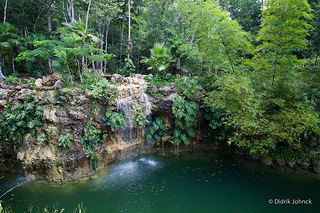 I find my way along Boulevard Kukulcan, named for the Mayan Plumed Serpent god, down through the hotel zone, the 17-mile stretch of beach that hosts some 30,000 rooms. I check-in, freshen up and surrender to some ceviche, a margarita and a dip. Then, an early sleep, to ready for the week.
I find my way along Boulevard Kukulcan, named for the Mayan Plumed Serpent god, down through the hotel zone, the 17-mile stretch of beach that hosts some 30,000 rooms. I check-in, freshen up and surrender to some ceviche, a margarita and a dip. Then, an early sleep, to ready for the week.
In the cool shadows of the morning I board a small bus, and down a flat highway we wheel to the Xenotes Oasis Maya, a new park that offers up a series of adventures in four cavernous flavors. The Mayans, in this rainforest, developed one of the most highly-developed civilizations in pre-
Columbian America. And they did it with a complete lack of surface water. How? The cenotes, limestone sinkholes that hold the flow from underground rivers, permanent fresh water that made life possible for the original inhabitants of the Yucatán Peninsula. The word “cenote” originates from the Maya “dzonot” meaning “well.” The word “Yucatán” originates, legend has it, when the Conquistadors asked the Mayans what they called their land. They replied, “Yucatán,” which means “We don’t understand you.”
It’s an edenic trundle into the park, and along the way Tania Solis Sanchez, our guide, leads us in a Mayan prayer to Aluxes, legendary guardians of the jungle, asking permission before entering their domains. She says the name of each of the cenotes is associated with the four elements of Nature and their Mayan origins: K’áak or Fire; Ha’ or Water; Iik’ or Wind; and Lu’um or Earth. Is it a coincidence, then, that Earth, Wind & Fire is playing at my hotel this week?
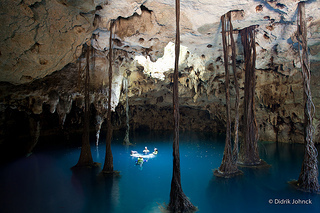 We park at the narrow mouth of the first cenote, and I lean cautiously over the edge, and gawk. One doesn’t have to be Mayan to feel the flush of wonder at this site. It’s more like a miniature Grand Canyon than a well, with what looks like a quiet river curling through. The misty diadem of a waterfall spills off the opposite edge of the canyon. Fellow explorers are padding inner tubes and inflatable boats; laughing and leaping from ledges into the cool, clear water, where the sounds of splashes ricochet up the walls.
We park at the narrow mouth of the first cenote, and I lean cautiously over the edge, and gawk. One doesn’t have to be Mayan to feel the flush of wonder at this site. It’s more like a miniature Grand Canyon than a well, with what looks like a quiet river curling through. The misty diadem of a waterfall spills off the opposite edge of the canyon. Fellow explorers are padding inner tubes and inflatable boats; laughing and leaping from ledges into the cool, clear water, where the sounds of splashes ricochet up the walls.
At the second cenote a couple of ziplines stretch from the forest into a vault of water, so we can fly like winged gods into the gallery. At the third, we snorkel the clear pool (where feet are nibbled with little fishy kisses… they should use this in a spa), and follow the flow into an underworld passage; and in the finale, we rappel down the mouth into an amphitheater that seems supported by vines, stalagmites, and spears of light. It seems a place where legends could be true, such as the stories that Maya practiced ritual sacrifice in these chambers; or that these pure waters are the fountain of youth, which seems entirely possible when our guide, who looks 23, claims to be 63. I take one last baptismal dip, just in case it’s true.
It’s all topped off with a glam picnic under a palapa in the jungle, fluttering with butterflies, bounded by iguanas, and featuring minestrone soup, artisan bread, deli meats, fine cheeses, water, soda, beer and wine.
The next morning, in the first blush of pink light, I take the 20-minute public ferry to Isla Mujeres, the legendary “Island of Women,” crossing beneath the supple wings of frigate birds, through a warm waft of wind to a dock bounded by small buildings and wooden-roofed fishing boats colored in weathered shades.
Perhaps the most evocative question looms with the landing: why is this called the Island of Women? Despite its redolent name, it is not a gynarchy. There are a few origin theories, of course, one of which has a pirate from Cuba landing and finding only females on the island, not knowing their husbands were out at sea fishing. The most popular notion has Francisco Hernández de Córdoba, commander of the first Spanish expedition, setting foot in 1517, and finding several small figurines of the Mayan fertility goddess Ix Chel.
Fertility is still a goddess today, but more in the realm of couples seeking the ideal wedding location, or honeymoon, or romantic get-away. Nothing here is inconceivable.
People come to Cancún to get away from the stress of big cities; people come to Isla Mujeres to get away from the crush of Cancún. It still holds onto some of that old, small-fishing-village, kick-back-in-the-hammock México character. Here, it’s always — Hammock Time.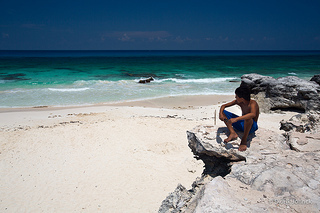
I rent a golf cart, the conveyance of choice, put peddle to metal and roar along at 10 miles an hour, flying over the many topes, or speed bumps, until a few minutes later I arrive at Playa Norte, a stunningly beautiful white beach that looks from a Corona commercial. I wade in up to my knees, and drop a quarter in the water. It’s so clear I can read the word “Liberty” above Washington’s visage without bending over.
I take octopus tacos, homemade guacamole and a chili-infused margarita at Capitan Dulche, a beach club in the shadow of a 100-year-old beached pirate ship. There are parrots, metal sculptures of musicians frozen in the act; a museum that celebrates local history from Mayans to buccaneers to Jacques Cousteau to the only Mexican aboard the Titanic; and the best bathrooms on the island.
After the lazy lunch I go nowhere fast; and do nothing firmly for the rest of the afternoon. That is how Isla Mujeres rolls.
In the bath of early morning light I board a boat heading out to find the whale sharks. We motor miles out into the open sea, well beyond the Great Maya Reef, second largest barrier reef in the world. Finally, beyond any trace of land, we see the notorious dorsal fins cutting through the surface. But, rather than retreat to safety in the middle of the boat, we don wetsuits, adjust masks, and slip over the side into a sea stirred gently by circling fins. Immediately I come face-to-face with the gaping maw of a 30-foot-long shark, sprouting upwards as though about to swallow me whole, man-brunch. I mumble something panicky into my mask, madly flip my flippers to get out of the way, and the giant glides past, body rippled and dotted, open-mouthed surging to the surface. The world’s largest fish, thankfully, feeds exclusively on plankton.
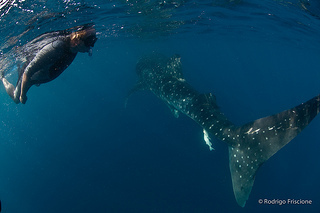 First, there was one. Then another. And another. Quite soon I’m surrounded by a score or more of the gentle beasts, each with a mouth the size of a steam shovel. Some sashay sideways; others go “botella, ” rising vertically to the surface to gulp down fish eggs and bubbles. Gills flow like ribbons; their bodies showcase Jackson Pollack-like splatter spots, where little cleaner fish cling. Calmer now, I hear only the whooshing of the water around me, my amplified breathing through the snorkel, and the sound of awe.
First, there was one. Then another. And another. Quite soon I’m surrounded by a score or more of the gentle beasts, each with a mouth the size of a steam shovel. Some sashay sideways; others go “botella, ” rising vertically to the surface to gulp down fish eggs and bubbles. Gills flow like ribbons; their bodies showcase Jackson Pollack-like splatter spots, where little cleaner fish cling. Calmer now, I hear only the whooshing of the water around me, my amplified breathing through the snorkel, and the sound of awe.
Rodrigo Friscione, our guide, is part of the family-owned Solo Buceo tour company, the first to be granted a permit to guide whale shark encounters back in 1998. He says this featureless spot features the largest aggregation of whale sharks in the world. “And you don’t even need to know how to swim to see them. Just put on a life jacket, stick your face in the water and watch the most beautiful creatures in the sea slowly swim by.”
That evening, back at the hotel, I belly up to the bar and ask barkeep, Fabian Barba, how to make the perfect margarita. He outlines his choice of ingredients: triple sec, lime juice, agave nectar, and when he gets to the part about the tequila, says: “It has to be a great tequila.” He suggests I check out the Tequila Herradura Sensorial Museum down the road. I remember when tequila was considered a cheap college drink, but wow have things changed… now it is dignified as posh liquescent art. Docent Lina Lopez transports me back to a bygone hacienda, festooned with blue agave, and there demonstrates the traditional artisanal method of crafting México’s national spirit. Then we retire to the sipping room, and sample some exquisite aromas and flavors, as though sipping the world’s finest cognac.
Under the ruddy light of early day I head over to the Moon Palace Golf & Spa Resort, which has the grounds and geometries worthy of a Mayan prince.
I’m not a great golfer, though enjoy the challenge. But here is a course that has a few challenges I’ve not encountered before… iguanas, coatis, and crocodiles. Besides the omnipresent jungle and mangroves, which frame the wide playing areas, the main feature is the extensive use of water hazards, and in those ponds and lakes swims some swarthy reptiles. It’s a Jack Nicholas signature course, so I know it’s exquisitely designed with no real danger of man-eaters, except perhaps at the bar, but just knowing they are there lends an extra thrill to the 27-hole-course.
After duffing about for the morning, I need a massage, so head over to the uber-elegant Le Blanc Spa, thick with bamboo gardens and tropical wood interiors. As the spa concierge lays a warm towel on my neck, the music and aroma-therapy envelopes, and I dissolve into something very low on the food chain. Sometime later, maybe days, I ooze over to the sauna with eucalyptus essence and soak in an hibiscus-festooned whirlpool. Then a pressure shower. Then, for the denouement: the fish spa. The spa imported garra rufa (or “doctor fish”), a species native to the Middle East that feed on dead human skin. They are then released in little tanks at the bottom of a massage chair. It tickles like the soft fishy kisses of the cenotes experience. According to my fishing guide, the pez treatments release fatigue, increase blood circulation, and aid in relaxation. For me, it prompts uncontrollable giggling, and a hankering for sea food.
So, that night I head over to Julia Mia, an inspired Mexican restaurant in downtown Cancún. It turns out Julia, the owner, is at the place, sipping tequila, and sprinkling her magic. She has integrated the recipes of her ancestors with contemporary formulas and flavors, and then mixed it up with her own secret ingredients to serve up what she calls “the most innovative dishes in Cancún.” She is telling the truth, if the chewy sope of marinated Octopus, steamed tacos, shrimp molcajete and churros with hot chocolate atole are any indication.
I need a glass of adrenaline the next day, so head over to the new and quite different experience, Exotic Rides, an open vitrine of Lamborghinis, Ferraris, Audis, a Lotus Elise, a Camaro SS, and a few go-karts (Richard Branson’s choice when he showed up here). You can sign up for a full-day trip learning to drive the Lamborghini Murcielago (which can go from 0-60 MPH in 3.3 seconds), or try strip racing on a quarter mile track, or, do what I did, sign up with a professional driver who will, in full Fast & Furious mode, take you “drifting” (intentionally skidding at high speeds) around the track while you “co-pilot.” I once flew with the Blue Angles, and was told after the flight that the pilots try to achieve two things with passengers. 1) To get them to pass out; and 2) to get them to throw up. I successfully resisted passing out. Now, as my driver slams the gas pedal until it is flush against the floor, blasting by color-coded cones that signal where to point the car, I bring up that old F-16 feeling… but, this time, manage to tamp it down. “How fast did we go?” I ask the driver after pulling off my helmet. “The speed of light,” he grins.
“What would happen if I drove the speed of light and turned on my headlights?” I ask.
“You’d get a speeding ticket.”
It’s time for the final dinner, and I choose one of the best eateries in the Yucatán: Lumière, inside the LeBlanc Hotel. It’s time to indulge, so I take on the seven course tasting menu, a series of small but insanely delicious dishes, including smoked duck and passion fruit coulis, foie gras croustillant over currant marmalade, lobster cappuccino, escargot, Carmenere and rosemary sorbet, Bordeaux glazed beef mignonette over baby spinach polenta, and something wicked called chocolate and vanilla snow obsession. A different and fitting dinning adventure to cap the week.
On the way to the airport I ask one of my guides why Cancún, which has not been as challenged as much of México with tourist revisionism, doesn’t just promote its Caribbean coordinates and keep its national roots at a whisper. It is, after all, a different place. “We’re proud of our country, and its tourism assets, and we shout that out. We don’t hide our pedigree. We want to be the doorway into México, and show the world that the delights found here are just samples of what México offers. We’re all different, and we’re all the same, but most of all, we’re all México.”
##
The post Mexico: The Different Cancun appeared first on We Said Go Travel.
Colorado: A Five Minute Walk to Heaven
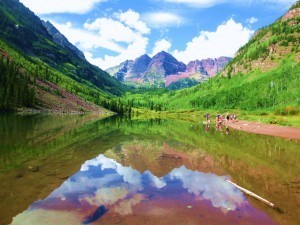 It took me nearly fifty years to finally take the five minute walk to the Maroon Bells, a destination that had been on my bucket list for over two decades. But what made this particular journey to see the twin peaks of Elk Mountain even more special, was the twelve year old boy who was playing in the mud puddles next to me, while happily munching on a dandelion.
It took me nearly fifty years to finally take the five minute walk to the Maroon Bells, a destination that had been on my bucket list for over two decades. But what made this particular journey to see the twin peaks of Elk Mountain even more special, was the twelve year old boy who was playing in the mud puddles next to me, while happily munching on a dandelion.
“Would you like some?” Mark asked, handing me a fist full of flowers.
“No thanks, but you better eat those quick before the park rangers see you,” I warned him.
Mark has cerebral palsy as a result of being born premature, which mostly affects his left leg and his ability to walk long distances or on difficult trails. He was wearing sheepskin Ugg boots to cushion his feet and suffers every day from some degree of pain, either in his feet or elsewhere in his body. He will tell you when he can’t walk anymore, but he always tries to walk as far as his feet will take him. Today, he had it easy. Our hike around Colorado’s most photographed peaks would be a short one.
Located just twelve miles southwest of Aspen, the Bells are also known as the “Deadly Bells” after eight climbers were killed in 1965. However for those wishing to simply hike around the area, access is shockingly easy. How many times had I admired the stunning images of the Maroon Bells, never imagining that they were literally only a short stroll from the car park?
People from all walks of life were heading alongside us toward the Mecca of Mountains. On the paved trail were people in wheelchairs, a group of bicyclists, a Chinese clan, a lady carrying her rollerblades and beagles busily sniffing at every bush in sight. Off in the distance, a young girl was learning how to fly fish, casting her line over and over into the glassy calm waters of Maroon Lake.
The panoramic view of the high purple peaks reaching upward toward the bluest of skies and reflected in the lakefront, takes your breath away. If ever there was a place that inspires awe and majesty and everything that is good in life, than it is there. You immediately feel the power of creation, gloriously painted across the purple and red mountainous landscape, enveloping every aspen grove and white dandelion field below. You feel humbled and happy to be alive and grateful that such a visually striking place even exists.
The grandeur surrounding us was in stark contrast from the topic of conversation that Mark and I had engaged in previously, while riding on the shuttle bus up to Bells. We had been talking about history and politics, (two of Mark’s most favorite subjects) and discussing the crisis in Syria. Not the typical conversation that you generally have with a twelve year old, but Mark is far from typical and has a mind as bold and as awe-inspiring as the mountains that we were admiring.
Mark was born in Singapore and has undergone daily therapy for most of his young life. He knows he is unique, which is both a blessing and a curse. His ever inquisitive mind, tirelessly seeks meaning and facts about the mysterious world around him and this sadly does set him apart – especially from kids his age. But on our enchanting hike underneath the shadow of the Bells, the history of the world and the politics of war, along with all the daunting facts and data stored in Mark’s brilliant mind fell away, taken over by a place that inspires something that we all seek; happiness and peace of mind. For more than five minutes in the refuge of Maroon Bells, we were both in heaven. Eating flowers and stomping in mud puddles.
The End
About the Author: Prisana Nuechterlein has flown in an ancient Russian helicopter in Laos, hitched hiked on the back of a coconut truck in Mindanao, and nearly boxed with sharks in the Similan Islands. A veteran traveler, her far flung adventures have been published in the Asian Wall Street Journal, The Bangkok Post, The Straits Times, Sawasdee Magazine (Thai International Airlines Magazine), The Phuket Gazette, Action Asia and numerous other publications. Visit her new travel blog.
The post Colorado: A Five Minute Walk to Heaven appeared first on We Said Go Travel.
September 26, 2013
Myanmar: Hindu Festival and Rainbow Restaurant (video)
WATCH: 42 Mandalay at night Hindu Festival and Rainbow Restaurant, Myanmar (Burma)
http://www.wesaidgotravel.com/ We Said Go Travel October 24, 2012 We were invited to participate at the Shree Ambika Hindu Temple for the last night of a festival. We thought Durga was returning to Shiva. But then we learned the row of cars was taking Shiva back to the river. I liked the girls in high heels and the energetic dancing!
We ate for the last time at Rainbow restaurant in Mandalay. Our favorite place to eat. Check it out! It is full of local men, very few women out and about at night here but many at the festival. Twenty seven days in Myanmar and 42 movies later, it is time to go back to Thailand.
This movie is from our 28 days in Myanmar (Burma) from September 28, 2012 to October 26, 2012 and our year TRIP in South East Asia, see all the videos from our trip: http://www.youtube.com/playlist?list=...
Our Memoir, Traveling in Sin, is available on Amazon.
Traveling in Sin is a HOT NEW Release on Amazon! from Lisa Niver Rajna
Traveling in Sin is a true tale of TRANSFORMATION thought LOVE and TRAVEL! After meeting online (on two different sites), George and Lisa travel internationally, give up their jobs, condo, ice cream and toilet paper in search of adventure and love. Along the way, Lisa sheds over 60 pounds and the couple gets engaged underwater in Thailand. There are tears, twists and true love!
Recent Press:
By Amy Sommer on Westside Today
By Dani Stone on Diets in Review
The post Myanmar: Hindu Festival and Rainbow Restaurant (video) appeared first on We Said Go Travel.
How to Make Friends While Traveling Solo
Most people who travel alone will tell you that they couldn’t imagine traveling in any other way, and they’re the kind of people that thrive on being by themselves. However, it’s a simple fact of life that people do need other people, and even the most independent of solo traveler knows that they need company every now and again.
If you’re not used to traveling alone, making friends on the road can be a very alien concept and seem impossible before you set out on your trip. However, with more experience and confidence building up as you go, meeting new people while going it alone isn’t actually as hard as it sounds. Here are a few tips to get you started out on being a solo travel social butterfly.
Pick your accommodation wisely
There are styles of accommodation that will make it really hard to meet people, and places where you’ll meet so many people that you’ll find it difficult to keep up with it all. If you stay in a regular hotel, a place that doesn’t have much of a social atmosphere to it, it can make it more difficult to talk to people. I find the kinds of travelers who stay in places like these are ones who like to keep themselves to themselves, which of course has a time and a place, but if you want to meet people there are better options out there.
Hostels, on the other hand, are completely the opposite, and the perfect place to stay if you’re looking to meet other travelers and people to hang out with. Use hostel comparison websites and reviews to figure out where the most popular hostels are, and you’ll be making friends from the moment you step in the door.
Figuring out what kind of accommodation is best for you to meet people in is step number one towards meeting people whilst traveling alone, so putting in the research here will definitely pay off.
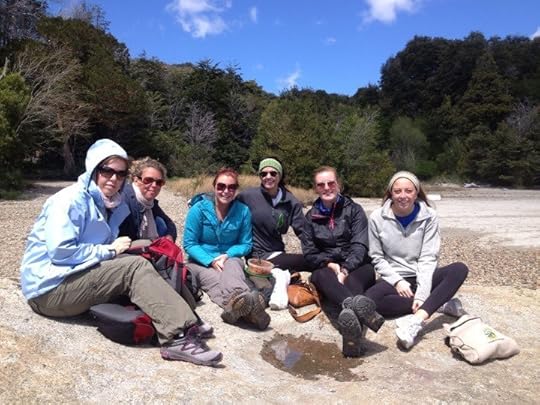
With a new group of friends from a hostel I was at in San Carlos de Bariloche, Argentina
Be confident
Confidence isn’t something that comes naturally to everyone, but when you’re traveling alone you sometimes need to throw yourself out of your comfort zone in order to get the most out of the experience. One element of this involves plucking up the courage to talk to new people, and even though it might sound like a daunting prospect at first, once you’ve traveled alone for a while it becomes much easier to be able to do this.
If you’re staying in a hostel, it’s incredibly easy to start talking to someone, and I’ve always said that’s one of the main things I love about hostels – they’re one of the very few places on the planet where it’s completely acceptable to strike up a conversation with the person sat next to you, and it in no way comes off as creepy. Make the most of having travelers around you, and chat to other people who might be traveling alone as they will be equally grateful for the company.
Get involved with Couchsurfing
Staying in a hostel isn’t the only way to meet people while traveling solo, of course, and websites such as Couchsurfing have revolutionised the way people get social whilst traveling. If you don’t fancy meeting a whole load of other travelers and would prefer to mingle with the locals, why not try your hand at Couchsurfing. This website connects travelers with locals and offers accommodation with a local to those people passing through the city.
Not only could you use it for finding a place to stay, Couchsurfing has also become a great way for travelers to connect through social events. Many cities have a weekly Couchsurfing meet-up, so always take a look through the events board for your destination on the Couchsurfing website to see if anything is going on during the time you’re there. The kind of people that use Couchsurfing are the kind that are willing to talk to anyone and everyone, and the open community it provides is perfect for the solo traveler looking to make new friends.

Me (far right) with Couchsurfing friends in Seattle
Take a tour, learn a language, and get social
Making friends while traveling solo essentially just involves putting yourself in the situation where you interact with others through a shared interest or activity. Taking a tour is one way to get chatting to other people, or signing up for a few language classes is another. Those are just two examples of things you could do to put yourself in a social situation, and I have found both to be very effective for making friends whilst on the road.
Sometimes making friends whilst traveling solo can really take you out of your comfort zone, but it’s something that comes naturally with more practice. Give yourself a little push each day to talk to someone new, and before you know it you’ll have friends all over the world.
About the author: Emma Higgins has been writing/traveling on and off since 2009. Her blog, Gotta Keep Movin’, is full of stories and advice from her trips, which include Europe, India, Morocco, South America, USA and Canada.
The post How to Make Friends While Traveling Solo appeared first on We Said Go Travel.
We Said Go Travel
We Said Go Travel is a global community of over sixteen hundred writers with articles from every continent.
Stories are shared with photos and video from a perspective of the transformative power of travel. We Said Go Travel has hosted live and online events as well as travel writing contests around the world. ...more
- Lisa Niver's profile
- 57 followers


